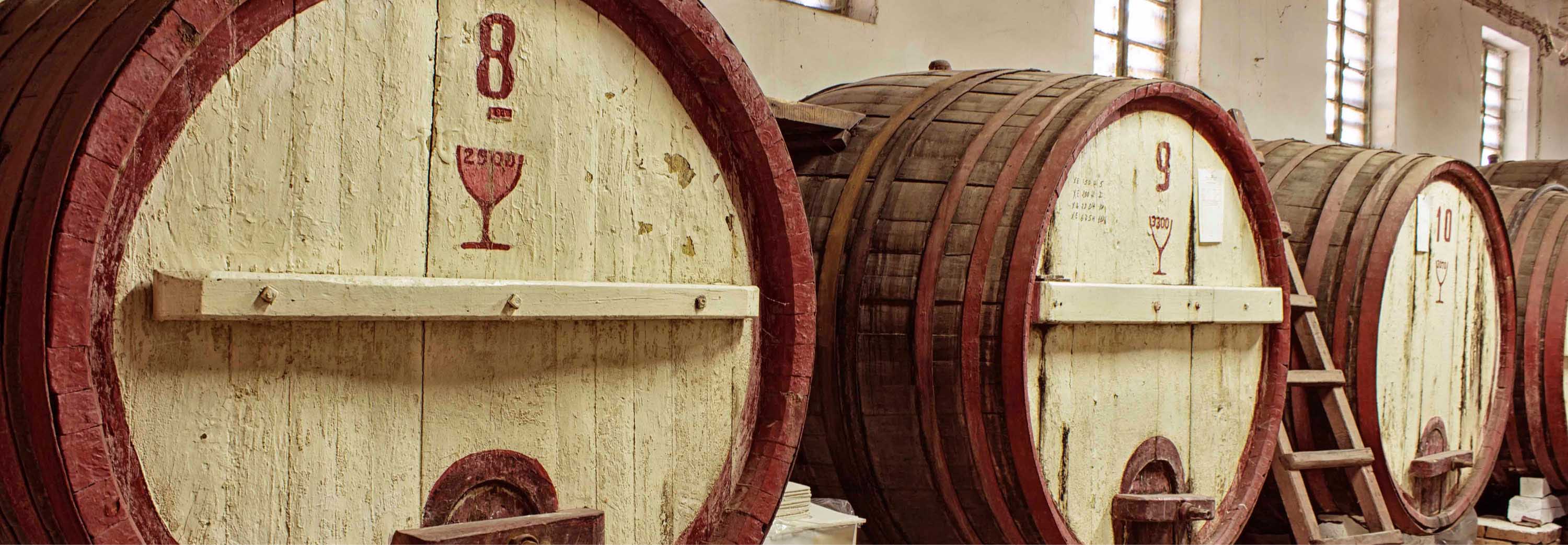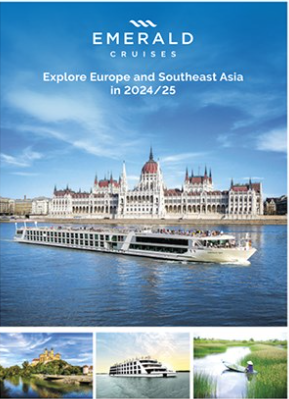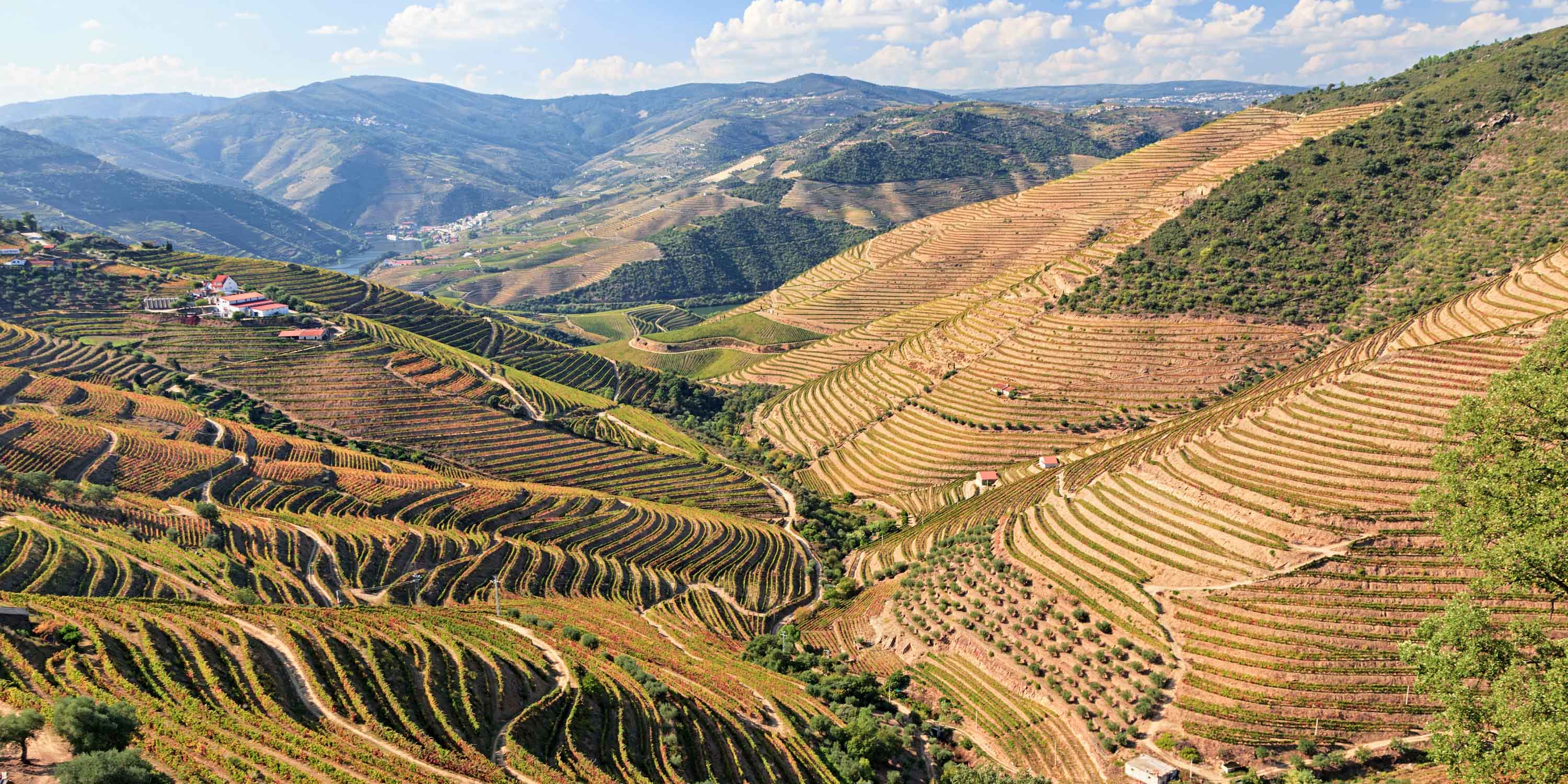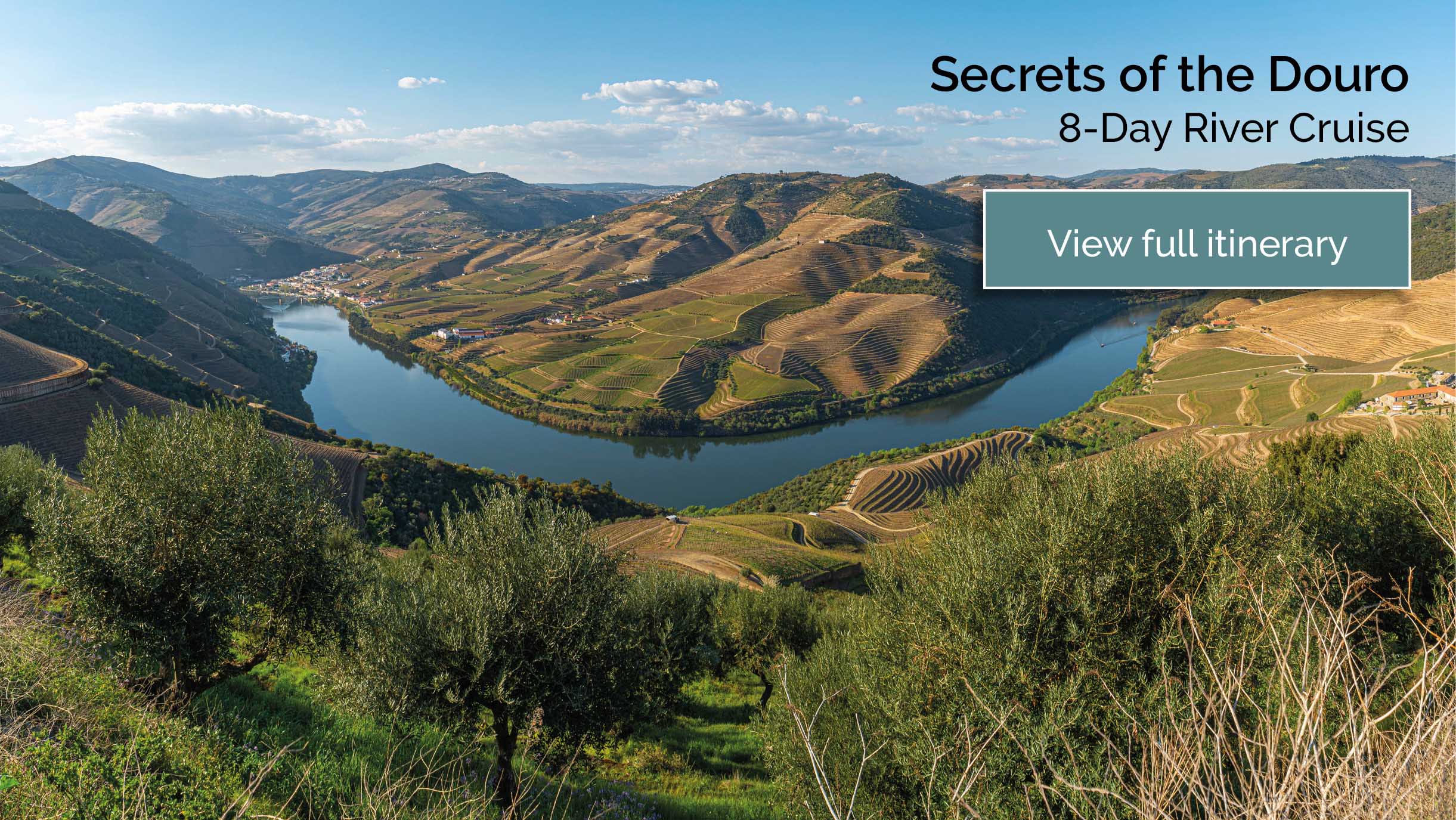A favourite tipple in Portugal, Port is the country’s home-grown wine, with a history as rich and as deep as its flavours.
Despite being much-loved and highly revered, the history of Port wine isn’t nearly as well known as the drink itself.
Below, we explore Port wine’s origins in detail. But first, let’s take a closer look at what Port wine actually is.
Below, we explore Port wine’s origins in detail. But first, let’s take a closer look at what Port wine actually is.
What is Port wine?
Port wine is a sweet, rich, fortified wine made from grapes grown in Portugal along the banks of the Douro Valley, often served as a dessert wine or as an aperitif. It’s named after the city of Porto, which is where Portugal as a country first took roots.
Types of Port wine
There are four main styles of Port wine to choose from. They are:
- Ruby
- Tawney
- Rosé
- White
While red wine is the most common type of Port wine, followed by Tawney (which is aged for a minimum of two years). Both are made from grape varieties such as Touriga Franca, Touriga Nacional, and Tinto Roriz, as is the rosé offering.
White Port wine is produced with grapes such as Malvasia and Gouveia.
Is all Port wine from Portugal?
For a wine to be officially labelled as ‘Port’ it has to come from Portugal, as it is protected under the European Union Protected Designation of Origins. However, there are Port-style wines produced in other countries such as:
- Argentina
- India
- USA
The history of Port wine
A favourite tipple since times of antiquity, wine has been cultivated in Portugal throughout the centuries. But Port didn’t rise to prominence until the latter half of the 17th century, with thanks to two brothers from Liverpool.
The brothers were holidaying in the Douro region while in Portugal to learn the wine trade, where they tasted a wine previously unbeknownst to them; a fortified wine crafted by the Abbot of Lamego, which left a lasting impression.
The abbot's methods killed active yeast cells during the fermentation process, leaving a sweet wine with high levels of residual sugar, vastly different from the wines of Britain. The brothers bought and shipped the abbot’s entire stock of wine back home, where it would gain great commercial success in Britain.
With the popularity of Port on the rise in Britain, the breakout of the Nine Years' War only accelerated the wine's success. The King of England, Ireland, and Scotland, William of Orange, placed high import taxes upon the wines of France amidst the conflict, driving wine merchants to seek their fortunes in Portugal, to great triumph.
Such was the overwhelming success of Port in Britain that less honourable wine producers began committing fraud, advertising non-Douro wines as being from the region, and artificially increasing the alcohol content using sugar or elderberry juice.
As news of such industry malpractice spread, the scandal caused sales within England to plummet and prices to tumble, causing the first decline in Port's history.
The brothers were holidaying in the Douro region while in Portugal to learn the wine trade, where they tasted a wine previously unbeknownst to them; a fortified wine crafted by the Abbot of Lamego, which left a lasting impression.
The abbot's methods killed active yeast cells during the fermentation process, leaving a sweet wine with high levels of residual sugar, vastly different from the wines of Britain. The brothers bought and shipped the abbot’s entire stock of wine back home, where it would gain great commercial success in Britain.
With the popularity of Port on the rise in Britain, the breakout of the Nine Years' War only accelerated the wine's success. The King of England, Ireland, and Scotland, William of Orange, placed high import taxes upon the wines of France amidst the conflict, driving wine merchants to seek their fortunes in Portugal, to great triumph.
Such was the overwhelming success of Port in Britain that less honourable wine producers began committing fraud, advertising non-Douro wines as being from the region, and artificially increasing the alcohol content using sugar or elderberry juice.
As news of such industry malpractice spread, the scandal caused sales within England to plummet and prices to tumble, causing the first decline in Port's history.
Port wine’s revival
The industry misconduct and the economic turmoil became of great concern to the Portuguese ruling classes, who were unwilling to let the economically prosperous product slip into obscurity.
At the turn of the 18th century, the Marquis of Pombal, a liberal reformist, was inspired to create the Companhia Gerald da Agricultura das Vinhas do Alto Douro. The General Company implemented sweeping commercial reforms and delineated the Douro wine region.
The move solidified the Douro as the only region sanctioned to produce authentic, labelled 'Port', reviving the Port market, and restoring commercial trust in Britain. Such was the success of the market reformation; in 1799, 44 million litres of Port were imported into England, the equivalent of five litres for every man, woman, and child in the country.
The rekindled success saw the Portuguese beverage become synonymous with Englishness, intimately tied to the English cultural landscape of the 18th century. Travel the Douro today, and it's impossible to ignore the anglicised names of the vineyards and distilleries—Sanderman, Dows, Cockburn, Taylors, and Croft, to name but a few.
The ubiquitous nature of Port within England was such that it reached the upper echelons of high society. A famous devotee of Port, British Prime Minister William Pitt the Younger, began drinking it as a child, reportedly as a cure for gout. In later life, Pitt became known as a ‘three-bottle man’, referencing his heavy consumption of Port. At this time, Port, much like Vermouth, was believed to have medicinal qualities and various Port 'etiquettes' developed because of this.
At the turn of the 18th century, the Marquis of Pombal, a liberal reformist, was inspired to create the Companhia Gerald da Agricultura das Vinhas do Alto Douro. The General Company implemented sweeping commercial reforms and delineated the Douro wine region.
The move solidified the Douro as the only region sanctioned to produce authentic, labelled 'Port', reviving the Port market, and restoring commercial trust in Britain. Such was the success of the market reformation; in 1799, 44 million litres of Port were imported into England, the equivalent of five litres for every man, woman, and child in the country.
The rekindled success saw the Portuguese beverage become synonymous with Englishness, intimately tied to the English cultural landscape of the 18th century. Travel the Douro today, and it's impossible to ignore the anglicised names of the vineyards and distilleries—Sanderman, Dows, Cockburn, Taylors, and Croft, to name but a few.
The ubiquitous nature of Port within England was such that it reached the upper echelons of high society. A famous devotee of Port, British Prime Minister William Pitt the Younger, began drinking it as a child, reportedly as a cure for gout. In later life, Pitt became known as a ‘three-bottle man’, referencing his heavy consumption of Port. At this time, Port, much like Vermouth, was believed to have medicinal qualities and various Port 'etiquettes' developed because of this.
The Napoleonic Wars & the Brazilian colonies
The turbulent history of Port wine does not end here. As Napoleon Bonaparte waged wars across the European states, pitting the French Empire against newly formed military coalitions, his martial efforts would again plunge the Port industry into disarray.
Amid the Napoleonic Wars, French and Spanish troops invaded the Douro, intent on damaging British trade economics. While the region's vineyards remained largely unscathed, the attacks caused a number of merchants to flee in fear, abandoning their wineries to the success of the French campaign.
Whilst eventually sales in Britain did recover, Port sales of the 19th century couldn't rival those of the previous century. The toll of the Napoleonic Wars, plus the diversifying tastes of the British public, saw other fortified wines, such as Sherry, rise to prominence.
With the longstanding Anglo-Portuguese alliance yielding fewer financial returns for Portugal, the nation diverted its attention to the colonies, namely Brazil. Whilst there is still a strong Port tradition in England and the wine's role within Britain doesn't have a closing chapter, Port's success and popularity would never exceed that of the 18th century.
Amid the Napoleonic Wars, French and Spanish troops invaded the Douro, intent on damaging British trade economics. While the region's vineyards remained largely unscathed, the attacks caused a number of merchants to flee in fear, abandoning their wineries to the success of the French campaign.
Whilst eventually sales in Britain did recover, Port sales of the 19th century couldn't rival those of the previous century. The toll of the Napoleonic Wars, plus the diversifying tastes of the British public, saw other fortified wines, such as Sherry, rise to prominence.
With the longstanding Anglo-Portuguese alliance yielding fewer financial returns for Portugal, the nation diverted its attention to the colonies, namely Brazil. Whilst there is still a strong Port tradition in England and the wine's role within Britain doesn't have a closing chapter, Port's success and popularity would never exceed that of the 18th century.


Old Wine Cellar, Porto
In Brazil, the efforts of the Portuguese authorities to establish and solidify a Port market would falter. With a growing independence movement gaining traction and Portuguese products boycotted, Brazil would eventually break from the Portuguese crown, gaining independence without ever truly embracing the fortified produce hailing from the Douro.
With Portugal seeking a trade solution and searching for new markets, a common enemy in viticulture arose; The Great Wine Blight.
With Portugal seeking a trade solution and searching for new markets, a common enemy in viticulture arose; The Great Wine Blight.
The Great Wine Blight
Threatening the existence of not only Port but many of the wines across Europe, The Great Wine Blight caused immeasurable devastation to the continent's wineries. The mysterious blight was caused by phylloxera, an aphid native to North America, conquering vineyards by feeding exclusively upon the roots of grapevines.
First noted in England, the infestation soon spread to France, destroying 6.5 million acres of Europe's most famed vineyards across the Rhone, Montpellier, Languedoc, and Bordeaux.
Portugal, too, soon fell to the blight, with plantations destroyed and their owners in financial ruin. Acres of desecrated vineyards led to many winemakers shifting their attention to other areas of agriculture, and Port was once again under threat.
Whilst we can mainly thank the methodology of the French botanist Jules Émile Planchon for our ability to enjoy the wines of Europe to this day, Portugal, likewise, has a hero in the fight against the blight; Antónia Ferreira.
Antónia Ferreira was a winegrower and champion of the Portuguese wine industry. She travelled to England amidst the blight to learn of the developing techniques for fighting phylloxera. Whilst many assumed the blight to be God's punishment for the sins of mankind, Ferreira rejected these woes, instead pursuing scientific methods.
Through trial and error, she developed techniques that saved and revitalised her vineyards, methods that later spread across the region in a wave of regeneration, stabilising the Port economy. Dying the wealthiest woman in Portugal, several of the Douro’s wine estates directly descend from Ferreira, and much of the Port enjoyed today is thanks to her efforts
First noted in England, the infestation soon spread to France, destroying 6.5 million acres of Europe's most famed vineyards across the Rhone, Montpellier, Languedoc, and Bordeaux.
Portugal, too, soon fell to the blight, with plantations destroyed and their owners in financial ruin. Acres of desecrated vineyards led to many winemakers shifting their attention to other areas of agriculture, and Port was once again under threat.
Whilst we can mainly thank the methodology of the French botanist Jules Émile Planchon for our ability to enjoy the wines of Europe to this day, Portugal, likewise, has a hero in the fight against the blight; Antónia Ferreira.
Antónia Ferreira was a winegrower and champion of the Portuguese wine industry. She travelled to England amidst the blight to learn of the developing techniques for fighting phylloxera. Whilst many assumed the blight to be God's punishment for the sins of mankind, Ferreira rejected these woes, instead pursuing scientific methods.
Through trial and error, she developed techniques that saved and revitalised her vineyards, methods that later spread across the region in a wave of regeneration, stabilising the Port economy. Dying the wealthiest woman in Portugal, several of the Douro’s wine estates directly descend from Ferreira, and much of the Port enjoyed today is thanks to her efforts
The Modern Era
Narrowly surviving The Great Wine Blight, Port soon entered another period of turmoil. In the late 20th century, the Carnation Revolution oversaw the overthrow of the Portuguese dictatorship, and the country entered a period of economic unrest, impacting almost every industry.
Port's fortunes changed, however, as Portugal's admission into the European
Union influenced the country's wine industry. Compliance with EU regulations democratised the Port market, and as with many industries after the fall of the totalitarian regime, foreign investment returned.
The democratisation and modernisation of Portugal's wine trade oversaw the production of various fortified wines made for international markets. Traditionally, Port makers didn't turn their hands to other forms of wine production, yet today, the lines are more blurred. Dry wines of the Douro are becoming frequently popular amongst international buyers, as is Vinho Verde, a green wine made from grapes harvested young.
Port's fortunes changed, however, as Portugal's admission into the European
Union influenced the country's wine industry. Compliance with EU regulations democratised the Port market, and as with many industries after the fall of the totalitarian regime, foreign investment returned.
The democratisation and modernisation of Portugal's wine trade oversaw the production of various fortified wines made for international markets. Traditionally, Port makers didn't turn their hands to other forms of wine production, yet today, the lines are more blurred. Dry wines of the Douro are becoming frequently popular amongst international buyers, as is Vinho Verde, a green wine made from grapes harvested young.
Port wine: Tasting notes, varieties & storage
All Port wines are sweet, though, with over 50 varieties of Port, levels and shades of sweetness vary. Tasting notes include ripe, musky berries such as raspberry and blueberry, with hints of chocolate and caramel. Often balanced with bold dishes and flavours, Port pairs notably well with aged cheeses, roasted meats, and rich desserts.
The four main varieties of Port in production are Ruby, Rosé, White, and Tawny. Ruby is made from red grapes native to Portugal. Rosé, adjacent to Ruby uses red grapes with Rosé wines employing slightly less skin contact to achieve paler colouring and lighter wine. White Port is made from local white grapes, and, finally, Tawny; is a barrel-aged red wine Port with a complex flavour profile and famous amber colouring.
Today, the Port industry is strong, with many pilgrimaging to the wine estates of the Douro every year. Wine tastings and tours are ever popular, and white grape varieties have become a favoured apéritif in Porto. Today the British market is substantial, with Port considered a premium drink with a strong association with moments of comfort and time spent with family.
Port storage follows the same rules as other red wines, with cool, dark places being the optimal storage environment. Some Ports, especially those aged or manufactured following traditional methods, are unfiltered, meaning that you're likely to find sediment within the bottle.
While the overall taste of unfiltered wines is unaffected by these sediments, Port enthusiasts often choose to limit their intensity by carefully extracting the cork with a corkscrew or using port tongs.
The four main varieties of Port in production are Ruby, Rosé, White, and Tawny. Ruby is made from red grapes native to Portugal. Rosé, adjacent to Ruby uses red grapes with Rosé wines employing slightly less skin contact to achieve paler colouring and lighter wine. White Port is made from local white grapes, and, finally, Tawny; is a barrel-aged red wine Port with a complex flavour profile and famous amber colouring.
Today, the Port industry is strong, with many pilgrimaging to the wine estates of the Douro every year. Wine tastings and tours are ever popular, and white grape varieties have become a favoured apéritif in Porto. Today the British market is substantial, with Port considered a premium drink with a strong association with moments of comfort and time spent with family.
Port storage follows the same rules as other red wines, with cool, dark places being the optimal storage environment. Some Ports, especially those aged or manufactured following traditional methods, are unfiltered, meaning that you're likely to find sediment within the bottle.
While the overall taste of unfiltered wines is unaffected by these sediments, Port enthusiasts often choose to limit their intensity by carefully extracting the cork with a corkscrew or using port tongs.


Douro River, Portugal
The Douro Valley region
Most of the region's vineyards stand upon the steep hillsides along the Douro River, one of Europe's most beautiful wine regions and the first region legally designated to produce Port. The warm climes contribute to the Douro's viticulture, and the mountains of the Marão shield the vineyards from the rain and winds of the Atlantic.
Never fortified, the landscape of the Douro is so unlike the German and Alsatian wine regions of the Rhine in that hillforts and ramparts aren't found here. The Douro is a landscape of wild terrain, sleepy villages, and acres of hillside viticulture.
Never fortified, the landscape of the Douro is so unlike the German and Alsatian wine regions of the Rhine in that hillforts and ramparts aren't found here. The Douro is a landscape of wild terrain, sleepy villages, and acres of hillside viticulture.
DiscoverMORE with Emerald Cruises
An Emerald Cruises river cruise throughout Europe's iconic waterways offers our guests the chance to uncover each city, town, and village we visit through several included excursions. For those guests looking to delve a little deeper and truly immerse themselves in local life, our DiscoverMORE programme offers a wealth of opportunities.
Unearth the Port region of the Douro with our extra-special DiscoverMORE excursions. Visit Quinta do Tedo with wine tasting; enjoy a Port wine cocktail lesson on board, and hike through the famous vineyards.
Ready to uncover Portugal and Port-producing regions of the Douro? Download your free European river cruising brochure to learn more about our itineraries and DiscoverMORE programme.
Unearth the Port region of the Douro with our extra-special DiscoverMORE excursions. Visit Quinta do Tedo with wine tasting; enjoy a Port wine cocktail lesson on board, and hike through the famous vineyards.
Ready to uncover Portugal and Port-producing regions of the Douro? Download your free European river cruising brochure to learn more about our itineraries and DiscoverMORE programme.


Your guide to river cruising
Download your free river cruise brochure to start planning your journey.
Stay up to date and be inspired
Yes, please keep me updated with the latest special offers, travel inspiration, product updates, and event invites.























